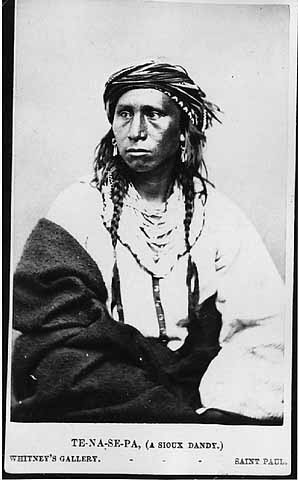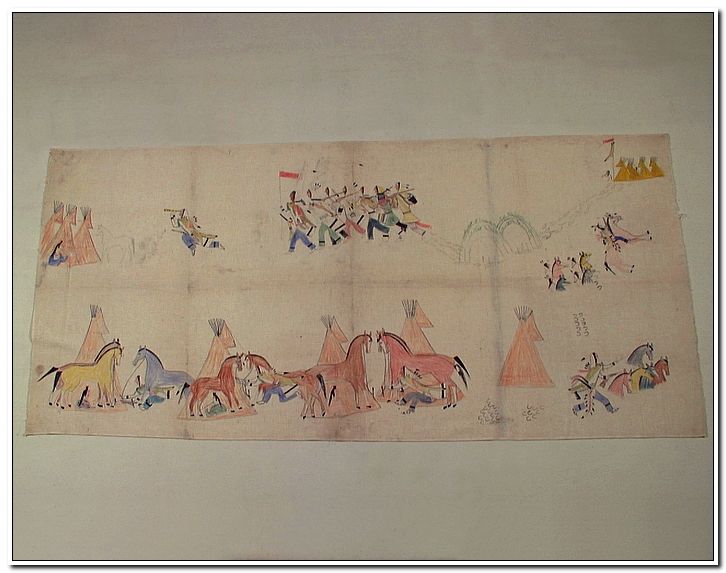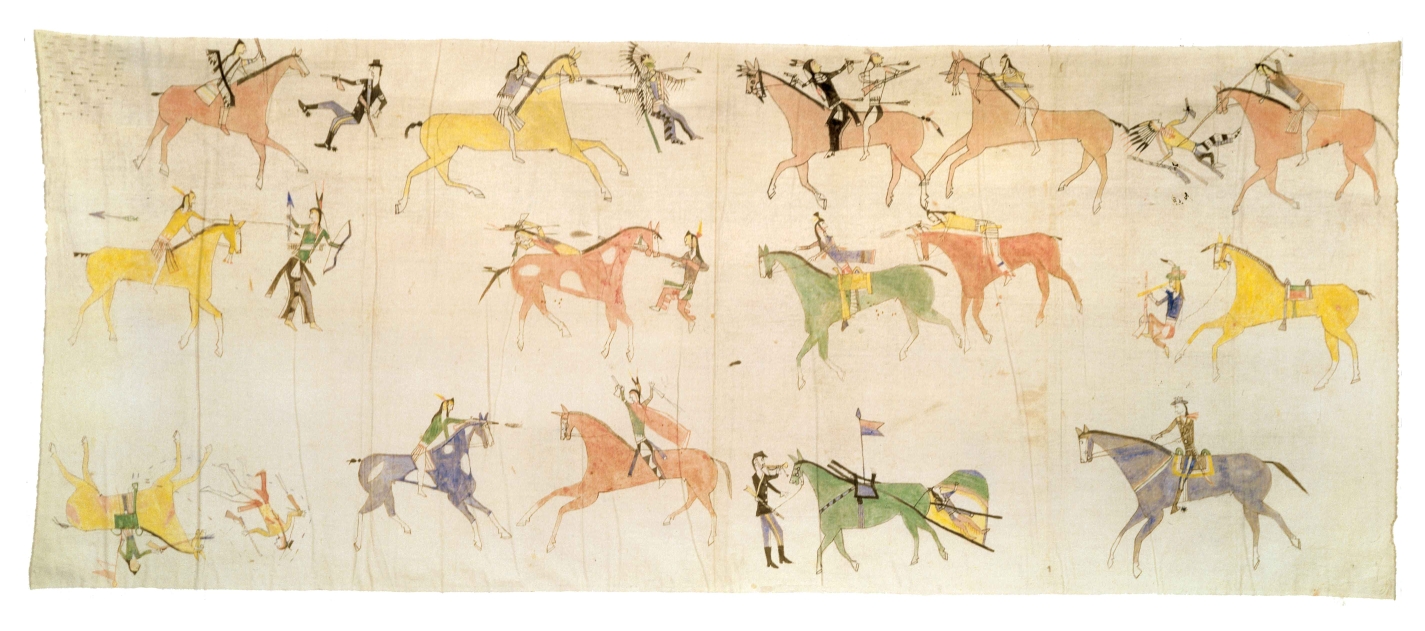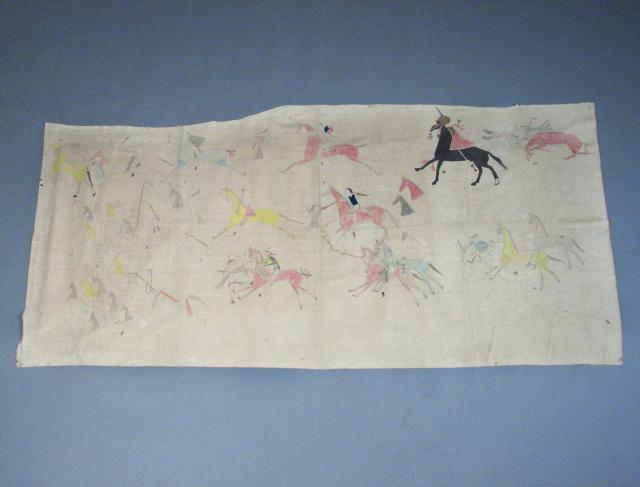|
|
Post by grahamew on Jan 11, 2015 4:20:28 GMT -5
Do you mean very specifically the type worn by the man at the right of this picture - which seems to be the same kind of combination worn by High Backbone in the Bad Heart Bull drawings (unfortunately, I couldn't find an example of this on the internet)? Yes Grahame, that is the type I'm referring to. The red cape was not always, but often, worn together with the red turban/hat. I do believe these to be different than the capes painted with protective designs as depicted in the top two visuals of your last post; these are more personal to the individual warrior and thus more akin to what whites invariably called "ghost shirts" or variations thereof. From what I have seen, the red war capes did not have any markings or drawings on them, except for a white border at the bottom sometimes. Great that the thread is finally alive btw! I'm assuming the white border is the white selvedge on what I guess a red stroud cloth |
|
|
|
Post by nicolas (carlo) on Jan 11, 2015 6:47:31 GMT -5
Yes that makes sense.
|
|
|
|
Post by nicolas (carlo) on Jan 11, 2015 6:57:49 GMT -5
I was wondering if the turbans were an influence from the Siouan speaking Dhegihan nations Ponca and Osage ? Part of Ponca/Osage mixed with Lakotas and formed the Lakota Wazhazha and Ashke bands and were also taken into Wacheunpa-Kiyuksa group. In old photos, we can see some of the males of Ponca and Osage nations wearing turbans. Could be Hreinn. Although I can't say for certain they are indeed turbans, they do seem to look like it. So a connection with those worn by the Ponca/Osage people is a possibility. Any idea on the significance of the turbans among those tribes? It's interesting that these type of hats, at least what I've seen, seem to be quite rare among the Lakotas, other than in connection with the red war capes. |
|
|
|
Post by chicheman on Jan 11, 2015 7:06:15 GMT -5
Hello,
maybe not 100 % right place here, since this is about Lakota, but regarding red capes among Plains Tribes, there is something handed down among the Kiowas, that I found in Kiowa Voices I (by Maurice Boyd, Texas Christian Univ. Press, 1981).
Short Story, The Red Cape Episode, tells about a brave warrior of the Kiowa Black Legs Society, Young Mustang, who captured a brillant red cape from a Mexican Commander who was wearing it. Young Mustang
acted with surprising boldness and jerked the red cape from the officer and killed him almost simultaniously. The Kiowa warrior brought the cape back to the Tribal camp circle and it became part of the symbolism of the Society, a Symbol of bravery because of the Action of the brave warrior Young Mustang who was also a Black Legs Society Leader.
Perhaps there was some similar symbolism and meaning of red capes among the Lakota People, just a guess.
Greetings from Germany
chicheman
|
|
|
|
Post by grahamew on Jan 11, 2015 8:45:21 GMT -5
I wonder if this a variant on the 'turban' in one of the Sitting Bull/Four Horns' drawings. No red cape this time, just what looks to be an army jacket:  It would be fair to say that the turban was also worn amongst the Dakota  I wonder, also, if it could just be some idiosyncratic way of depicting a headscarf or cloth tied around the head. |
|
|
|
Post by dT on Jan 11, 2015 10:35:03 GMT -5
I am reminded of the Crow Scouts who served with Custer, but refused to fight at the Little Bighorn. Custer wanted them to wear Army tunics - presumably so they would be identified as being on the same side as Custer's men. This way, the Scouts would not be shot by the Cavalry. However, the Scouts refused ... because they wanted to wear traditional Crow regalia in the battle. When Custer refused to allow them to do this, they left the battlefield. This is why they survived the fight.
Why did the Crows want to wear their regalia? Because if they DIED in battle, then they were properly prepared for death. You can never be sure what will happen to your body after a battle, and you may not be buried by your own people. It could be a lonely death - with great pain. Therefore, from this point of view it does make sense for them to wear regalia while fighting.
This may explain the red capes. Some people here have already said that the red cape had ceremonial purposes for death. Therefore, it does make sense for warriors to choose it during the battle.
dT
|
|
|
|
Post by hreinn on Jan 11, 2015 10:42:53 GMT -5
It would be fair to say that the turban was also worn amongst the Dakota and there's a photo of a Lakota or Yankton or Yanktonai wearing one: A possible explanation of the "turban fashion" among Poncas, being transfered to the Dakotas, can be explained with the following: During the 1830s the Ponca were generally thought to be allies with elements of the Yankton Dakota and the Teton Lakota and frequently joined with them in warfare against the Pawnee. |
|
|
|
Post by hreinn on Jan 11, 2015 11:02:59 GMT -5
I wonder if this a variant on the 'turban' in one of the Sitting Bull/Four Horns' drawings. Similar or same "headdress" seems to be known among the Poncas and Osages: Black Crow (Ponca)  Not Afraid of Pawnees (Osage)  |
|
|
|
Post by grahamew on Jan 11, 2015 11:52:04 GMT -5
Well, shortly after my last post, I came across a drawing by His Fight (Jaw), part of the Mary Collins Collections at at the SDSHS, collected after 1885; two feature Okicinintawa in a red cloth cape, but in one, he's wearing the red 'turban' or whatever, with an eagle feather sticking upright out the back. Janet Berlot suggests that the red cloth may have been the wrapping of his war medicine and would have served as a form of protection. Unfortunately, I haven't found this image on the internet and my scanner has been dead for a while. Berlot - Plains Indian Drawings 1865 - 1934; p 184. Interestingly, in his drawing of a winter horse raid against the Crow, there's a red cloth tied to a pole outside his tipi and when he leads the raid, he carries a pole or lance with the cloth and his wolfskin attached to it, later wearing the latter on his back.  |
|
|
|
Post by grahamew on Jan 13, 2015 12:04:07 GMT -5
Here are two drawings by His Fight/Jaw. One is the drawing mentioned above; the other shows him wearing the cape but not the headband/turban:  |
|
|
|
Post by gregor on Jan 14, 2015 2:35:52 GMT -5
Ok, convinced - there were these war capes / cloaks. Often with protective signs.
One thought: could it be that these capes replaced shields with protective signs?
|
|
|
|
Post by rodthomas on Jan 19, 2015 15:19:09 GMT -5
Crow and Nez Perce warriors also wore red capes. White Swan's painting at the Heard shows him with one on in the upper right as well as attacking a cape wearing foe in the bottom line to the left.  [entered to upload the photo - Dietmar] |
|
|
|
Post by rodthomas on Jan 19, 2015 15:36:27 GMT -5
Well, sorry...now I know how to properly add attachments AND not send at the same time!!!
White Swan shows himself in this event wearing a white-trimmed red cape in all his portrayals with it.
Hope all is well...
Regards, Rod...
|
|
|
|
Post by nicolas (carlo) on Jan 21, 2015 5:28:47 GMT -5
Thanks for sharing Rod. Would be interesting if the wearing of these red capes in combat among the Crows and Nez Perces had the same significance as the red war capes among the Lakotas. Since we do not know for certain their significance among the Lakotas, we may never know if there was indeed a link (or, as Hreinn pointed out, with other Plains tribes such as the Cheyennes.) Given that borrowing of customs occurred freely among the Plains tribes, even among enemies, a shared significance of the red capes would at least be a possibility.
|
|
|
|
Post by grahamew on Feb 8, 2015 6:39:23 GMT -5
Unfortunately, I have no idea at all where I took this Lakota muslin tipi/cabin liner from (yes I do: Milwaukee Public Museum), but at the top right. there's another example of the cape/headgear combination:  Detail: Here's a detail from a White Swan painting (depicting the same incident shown on the top row of the drawing Rod posted above). The man at the back of the horse seems to have the same kind of cloth headgear (note the ties), but this time, it's a different colour - unless I've completely misread this and it's some kind of animal skin. No cape this time, however:  Looking through Rod's book, I noticed a hide painting from the Staatliches Museum in Munich (pp.208-209)depicting a fight between Lakota and/or Cheyenne against soldiers and Crows in which one man is wearing what looks like red cloth over his head and is dressed in (as are several other men) converted army coats and maybe trousers (or the stroud variations thereof that can be seen in photos), which seemed - as do the hairplates worn by a couple of the men - to be in vogue in the 1860s. It's hard to make it out, but it looks more like a headscarf. However, in the large painting by Standing Bear ("Events Leading to the Battle of the Little Big Horn), there'a warrior towards the top left who appears to be wearing another example of the cloth headgear - though no cape. It's difficult to make out, but it looks as if there are definite red stroud ties, complete with the selvedge, though the top itself looks darker. Like several other example, there is a feather poking through the top and I'm leaning towards the idea that these are braid bands of stroud wrapped around the head and tied at the back, with the top open, not unlike the way a fox-skin would be worn. On the other hand, maybe they are turbans: "At 9 o'clock entered Sitting Bull, accompanied by Spotted Eagle and the rest of their delegates. For the first time since last Sioux War appeared now for the white era's most remarked Indian. Neither the most barbarous ignorance, cruelty and ferocity as evinced in the natural history of the peoples have the slightest extent affected the expression of combined femininity and masculinity that characterize Sitting Bull's physiognomy. Less serious than Sata Moventas, less clear-cut than the Spotted Tail and intelligent than Red Clouds were his features, like Goethe's a treat for the senses. He smiled calmly and ironic. His black hair billowed down around his beardless, brown cheeks, over his finely shaped ears that are not burdened by any jewelry. The red turban had been replaced with a hat in wolf skins. On the upper body he wore a black cotton shirt with large white dots. Beneath the blanket, which he carelessly wrapped on itself, appeared a couple of richly beaded moccasins, his only ornaments. " - Jerome Stillson, Fort Walsh, 17 Otober 1877 (writing for the New York Herald) from www.borjedorch.se/Sitting%20Bull/bull_fotografier.html |
|